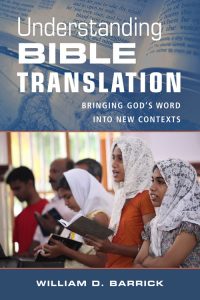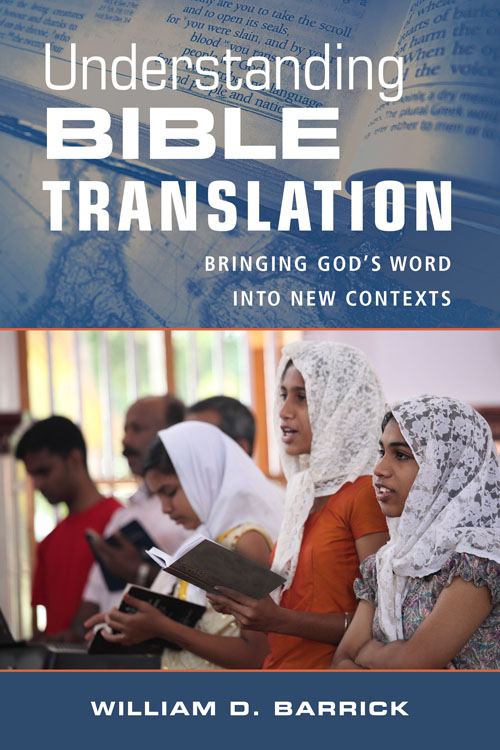Barrick, William D. Understanding Bible Translation: Bringing God’s Word into New Contexts. Grand Rapids: Kregel Academic, 2019, 248 pp, $21.99, paperback.
All eyes were transfixed on the speaker who ascended the lectern. As he opened the sacred book, the hushed crowd rose together as if on cue. After a blessing the standing throng uniformly put their faces in the dust. The Word of God was about to be read! But the reading sounded strange, most struggled to understand the foreign words. Expectant hearts began to grow disillusioned until another man stepped forward to translate the text into the common tongue (Neh 8:1–8). Thus began the history of Bible translation, from Mosaic Hebrew to the Aramaic of the exiles.
Bill Barrick offers readers a window into this history as well as the intricacies and importance of translating God’s Word into the common languages of the world. Barrick’s resume makes him an excellent guide for such a journey: 15 years as a Bible translator in Bangladesh, 50 years of teaching Hebrew and Old Testament, and a contributor to multiple English Bible translations (ESV, NET, LEB). Having taught for many years at The Master’s Seminary, he currently serves as the OT editor for the Evangelical Exegetical Commentary series with Logos/Lexham Press. He is currently writing the Genesis volume for that series, having previously written a commentary on Ecclesiastes for the Focus on the Bible series (Christian Focus, 2011). He has also contributed to numerous other works, including The Inerrant Word (Crossway, 2016), Four Views on the Historical Adam (Zondervan, 2013), Coming to Grips with Genesis (Master Books, 2008). He serves as an elder in his local church and regularly co-leads creation oriented rafting trips through the Grand Canyon. His experience in the local church, academic scholarship, and field Bible translation offers him a unique vista from which to present the principles and priority of Bible translation.
Barrick begins by going backwards into the history and priority of “common language” Bible translations. Beginning with the earliest translations, he discusses the significance of the Septuagint [LXX] (a translation of the OT into the Koiné or “common” Greek of the period). This translation not only served as 3/4 of the Bible for most of the early church population, but it also became the basis for many other early translations (p. 26). Also of note, the Syriac Peshitta (meaning “simple” or “common”) and the Latin Vulgate (meaning “vulgar” or “common”) follow the LXX approach of translating God’s Word into the common language of a people, not a highly formalized dialect inaccessible to many readers (p. 27). Barrick then goes on to draw out the significance of this issue in the Reformation era where Bible translation into the common languages of Europe helped to fuel that movement. He concludes that a good translation should be accurate, understandable, and clear (p. 31).
Throughout the book, Barrick is careful to point out that translation and exposition of the text are not the same tasks. A good translation serves expositors and teachers, it does not replace them. He writes, “Translation does not eliminate the need for exposition and teaching. Nor does translation ignore the responsibility of the reader of God’s Word to obey what they do understand. . . . Difficult as it might be, translators must allow the biblical text to force readers to think, rather than to be lazy in their approach to the text” (p. 38). His comments echo the apostle Paul who wrote to Timothy, “Think over what I say, for the Lord will give you understanding in everything” (2 Tim 2:7, ESV).
After the first two chapters, much of the discussion turns to concrete translation principles and examples, mainly from English translations. He discusses how issues of semantics [ch. 3], simplicity [ch. 4], and theology [ch. 5] impact a translation. He summarizes his approach stating, “Sound translation principles require transferring the exact meaning of the original text into the receptor language while maintaining as much of the original wording as possible” (p. 64). He then goes on to analyze in detail how various English translations approach Psalm 23, Proverbs 8:1–11, and Romans 6:8–14. He concludes, “Essentially literal Bible translations provide superb versions for in-depth Bible study, but might not always speak directly to the heart of someone encountering the Bible for the first time—especially in a context characterized by biblical illiteracy” (p. 156). In other words, different translations have different purposes. It is important for readers, especially those with choices among translations, to understand the usefulness of each approach.
Barrick directs this book mainly to church leaders and interested church members, but one of the final chapters provides some helpful clues as to what makes a good translator. His catalog of skills and attributes can assist both an interested reader and an observant pastor looking for potential missionary candidates. And while Bible translation can appear to be a very human task, Barrick recognizes the spiritual dimension of the work in a detailed call to prayer (p. 219). He concludes the book be reflecting on the significance of this dimension of missionary work, “Long after the Bible translator or translation team has completed their work . . . the Bible continues on to produce spiritual fruit. Its words convert, instruct, encourage, strengthen, guide, and comfort generations of believers yet unborn. No other book possesses such power and potential” (p. 220).
I appreciate the measured and precise approach that the author brings to this topic. He bridges important conversations between the communities of scholarship, missions, and the church. His philosophy of translation strikes a winning balance, “Sound translation principles require transferring the exact meaning of the original text into the receptor language while maintaining as much of the original wording as possible” (p. 64, emphasis added). In other words, interpretation is a necessary part of the translation process, but a good translator will stay as close to the words of the original as possible. This conviction flows from an understanding of how the Bible functions in the life of the church and the individual believer. The NT clearly ordains the role of “pastor-teacher” in the life of the local church (Eph 4:11–12). Thus, a proper translation will seek to equip these leaders for their teaching ministry as they equip the local body (cf. p. 38). While Barrick recognizes that more “dynamic” translations may have a role to play in evangelism and church life, he posits that Christian growth in biblical and spiritual knowledge will lead them to desire a more direct translation for study and teaching (p. 156).
Barrick also does well in illuminating the theological nature of the task of Bible translation. While writing as a moderating voice, I appreciate that Barrick still takes a clear stand on the inerrancy of the original writings of the Old and New Testaments (p. 217). This conviction on inerrancy, echoing the Chicago Statement, impacts other assertions throughout the book. He writes, “Translators must not add meaning, nor must they subtract any of the meaning. The goal should be to accurately and fully translate the text into its receptor language. . . . The accuracy of one’s theology must rest upon the original text [i.e., the Hebrew and Greek manuscripts]” (p. 120–121). This leads him to emphasize the principles of clear and accurate translation (p. 156). As Hill et. al. write, “[Bible] translators are not as free to adjust the text to the audience’s context as they can in other retellings. . . . Bible translation is a genre which raises the expectation that the meaning the audience can understand from the translation will have a high degree of resemblance to the meaning the original author intended to communicate” (Bible Translation Basics [Dallas: SIL, 2011], p. 110–111). So, while a translation team must be concerned that their translation is understandable and natural in style, theological convictions about the very words of the text demand detailed attention to the words of the apostles and prophets.
No native speakers of biblical Hebrew and Koiné Greek remain on the earth. Thus every Christian today is somehow dependent upon the faithfulness of Bible translators through the ages. Bill Barrick proves to be an excellent guide into the history, significance, and principles of this historic task. I would highly recommend this book for pastors and church leaders who want to understand better how the translation they depend upon weekly came into being. It is also incumbent upon those of us with such a wealth of translations and Bible knowledge to share this with the over 1,600 languages who still have nothing translated, and the over 3,300 who only have partial Bibles. Imagine doing church ministry without the “whole counsel of God” in a language you know best! Barrick’s contribution goes a long way in advancing our appreciation for our own Bibles and spurring us to face the task unfinished.
Marcus A. Leman
Southern Baptist Theological Seminary





